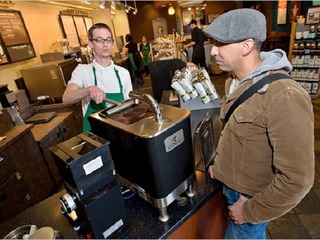
Nest gives big upgrades to its Thermostat and apps
Mobile apps will now incorporate new smoke alarms and carbon monoxide detectors

The Nest Thermostat is probably the most well known device in the up and coming Internet of Things space. It is a small and simple tech device that learns your patterns and preferences to efficiently heat and cool your home and help you save energy. And who doesn't love that?
Nest has begun branching out a bit, debuting new carbon monoxide and smoke detectors, aka Nest Protect devices, last month. And so now the company is unveiling a big upgrade and a bunch of new features, along with both of its mobile apps, in order to incorporate these new devices, Nest announced on Friday.
"The app is getting a full redesign: since you control both Nest Protect and the Nest Learning Thermostat from one place, we updated the mobile app to fit—and work better—for both," Nest wrote.
So here's what's new:
There is now a button on the app that lets users switch from home to away, rather than having to tilt the app. The app will also now notify users if the AC is cooling/heating or if it is idle, based on the color of the icon.
Nest also added an icon representing all the Nest Protects devices. If there is no problem, the user will see a green ring. If there is a problem, the ring will change to a different color, either yellow or red.
In addition, Nest has included a whole bunch of features for its smoke alarms and carbon monoxide detectors, including the status of its batteries and sensors of every alarm. It will check a wired Protect device every half hour, and a battery powered device every 24 hours.
And, of course, it will tell you when you need to change your batteries. Whenever this happens, or there is an emergency, the user gets a notification on their phone.
As for the Nest Thermostat, that is getting some new features as well. They include the ability to control humidifiers, improved heating features and the ability to connect to improve the Auto-Away algorithm and shut down the heating system if there’s a CO emergency.
The updates will be pushed out over the next few days. All of these updates are automatic, so users do not have to do anything to get them.
The Internet of Things
The Internet of Things, essentially, it is a network of devices that are connected via sensors to maximize the potential of each object. And, while that may not sound all that exciting, it is when you hear some of the possibilities that can come from these sensors.
For example, you can have an alarm clock that is connected to your commuter train, which will ring early if there is a delay. Or you can buy a fork that will tell you how long it took to eat your meal and how many bites you took, to help you lose weight. Or a car that can drive itself.
This is a category that General Electric wrote could be worth $10 to 15 trillion by 2030. One that a survey from Zebra Technologies in October found was already in place in 15% of organizations around the world, and one that 53% of those organizations planned to implement within the next year. The possibilities for what can be achieved are pretty exciting.
Companies in the space are also starting to raise money. Zonoff, provides a software platform to its channel partners, who deliver “Connected Home” devices and services to consumers, raised $3.8 million earlier this year.
Nest also raised $80 million back in January of this year.
Even Starbucks is getting in on the action, by saying it will double the number of Clover coffee-brewing machines it operates over the next year.
These coffee makers are connected to the cloud and allow stores to not only track customer preferences, but for recipes to be digitally updated and to allow employees to monitor how a coffee maker is performing. Starbucks has installed roughly 500 of the coffee makers since 2008.
(Image source: https://nest.com)
Related News


